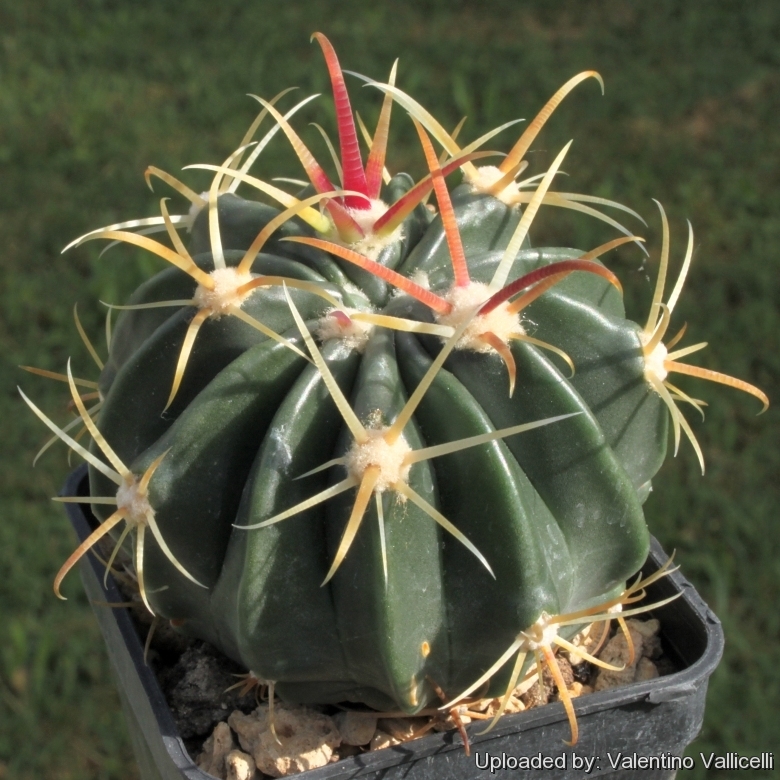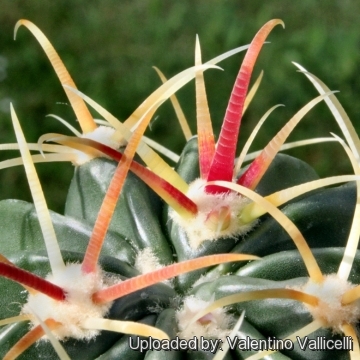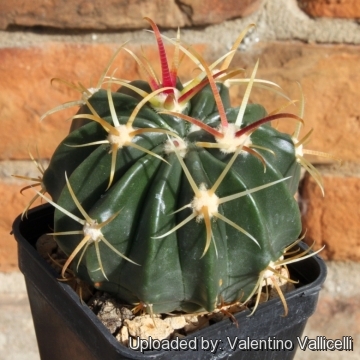Donate now to support the LLIFLE projects.
Your support is critical to our success.
Your support is critical to our success.
= Ferocactus cornigerus (DC.)
[Basiaonym: Echinocactus cornigerus DC. 1828]
Accepted Scientific Name: Ferocactus latispinus Britton & Rose
Cactaceae (Britton & Rose) 3: 143. 1922 [12 Oct 1922] Britton & Rose

Cactus cornigerus (Ferocactus cornigerus) Photo by: Valentino Vallicelli
Synonyms:
- Ferocactus cornigerus (DC.)
- Bisnaga cornigera (DC.) Orcutt
- Cactus cornigerus Moc. & Sessé ex DC.
- Echinocactus cornigerus DC.
See all synonyms of Ferocactus latispinus
back
Accepted name in llifle Database:Ferocactus latispinus Britton & Rose
Cactaceae (Britton & Rose) 3: 143. 1922 [12 Oct 1922]
Synonymy: 26
- Ferocactus latispinus Britton & Rose
- Bisnaga latispina (Haw.) Doweld
- Bisnaga recurva subs. latispina (Haw.) Doweld
- Cactus latispinus Haw.
- Echinocactus cornigerus var. latispinus C.F.Först.
- Echinocactus cornigerus f. latispinus (Haw.) Voss
- Echinocactus latispinus (Haw.) hort. ex C.F.Först.
- Echinocactus recurvus var. latispinus (Haw.) Mittler
- Ferocactus latispinus var. latispinus (C.F.Först.) Backeb. & F.M.Knuth
- Mammillaria latispina (Haw.) Tate
- Melocactus latispinus (Haw.) Pfeiff.
- Ferocactus cornigerus (DC.)
- Bisnaga cornigera (DC.) Orcutt
- Cactus cornigerus Moc. & Sessé ex DC.
- Echinocactus cornigerus DC.
- Ferocactus latispinus var. flavispinus (Haage ex C.F.Först.) Backeb. & F.M.Knuth
- Echinocactus cornigerus var. flavispinus Haage ex C.F.Först.
- Echinocactus latispinus var. flavispinus (Haage ex C.F.Först.) F.A.C.Weber in Bois
- Ferocactus recurvus f. flavispinus (Haage ex C.F.Först.) G.Unger
- Ferocactus latispinus var. flavispinus f. cristatus hort.
- Ferocactus latispinus var. greenwoodii (Glass) N.P.Taylor
- Ferocactus cylindraceus var. greenwoodiae (Glass) N.P.Taylor
- Ferocactus latispinus subs. greenwoodii (Glass) N.P.Taylor
- Ferocactus recurvus var. greenwoodii Glass
- Ferocactus multangularis (Voigt ex Steud.)
- Cactus multangularis Voigt ex Steud.
Ferocactus latispinus subs. spiralis (Karw. ex Pfeiff.) N.P.Taylor
Cactaceae Consensus Init. 5: 13. 1998
Synonymy: 15
- Ferocactus latispinus subs. spiralis (Karw. ex Pfeiff.) N.P.Taylor
- Bisnaga latispina subs. spiralis (Karw. ex Pfeiff.) Doweld
- Echinocactus spiralis Karw. ex Pfeiff.
- Ferocactus latispinus var. spiralis (Karw. ex Pfeiff.) N.P.Taylor
- Ferocactus recurvus f. spiralis (Karw. ex Pfeiff.) G.Unger
- Ferocactus nobilis (L.) Britton & Rose
- Cactus nobilis L.
- Echinocactus nobilis (L.) Druce
- Ferocactus recurvus (Mill.) Borg
- Bisnaga recurva (Mill.) Orcutt
- Cactus recurvus Mill.
- Echinocactus recurvus (Mill.) Link & Otto
- Echinocactus stellatus Scheidw. non Speg.
- Echinofossulocactus recurvus Lawr. in Loudon
- Ferocactus latispinus var. recurvus (Mill.) Lodé
back

Cactus cornigerus (Ferocactus cornigerus) Photo by: Valentino Vallicelli

Cactus cornigerus (Ferocactus cornigerus) Photo by: Valentino Vallicelli
| Your Actions | |
|---|---|
| Back to Cactus index | |
| Back to Cactaceae index | |
 |
Back to Cacti Encyclopedia index |









